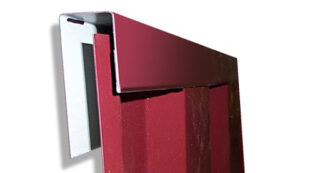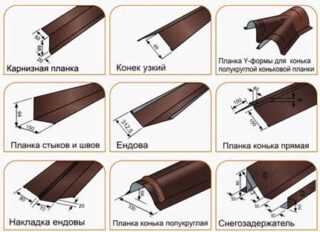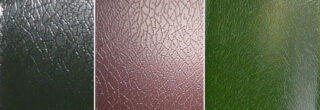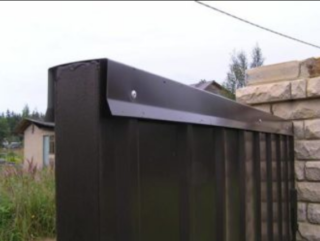The upper bar for a fence made of corrugated board is an additional element that is attached to the top of the fence at the end of its construction. It performs a decorative function and prolongs the service life of the structure. Without it, a fence made of corrugated sheets fixed on logs will not collapse, but it will stand for a shorter period and will not look so presentable. In sectional structures, the fence strip for corrugated board is an element of the frame, therefore, it will not work to build a fence without it.
Description and functions

Additional elements are various types of additional components used in the installation of roofs, fences and other structures and bearing a functional and aesthetic load. One such example is a fence bar. The product is a piece of steel sheet bent in the shape of the letter "P".
The plank on the profiled sheet for the fence has a width identical to the wave height of the profiles used for the installation of the fence. If you attach it to a structure, it will sit tightly on it. Its shoulders (or one of them) are bent inward to make the product stiffer and minimize moisture ingress, which prevents the development of corrosion. The upper part can be made in the form of a flat plane or have the shape of a triangle.
The bar performs several functions at once. Its installation helps to extend the life of the fence. Abundant ingress of water on the profiled sheet causes corrosion, corroding the material. The most susceptible to these processes are areas where the coating is damaged or missing - the edges of the flooring elements and the places around the points of fixation to the base. The rubber gaskets of the self-tapping screws used for installation help to protect the latter. To protect the edges from moisture, corrugated board strips are used.
Installing the overlay helps to make the structure stiffer. The edging distributes the load evenly along the length of the sheet. As a result, the top of the fence will not undergo deformation if, for example, a basketball arrives at it.
Installation of a fence strip made of corrugated board will make the structure visually attractive. The shape of the corrugation predisposes to the fact that the top of the fence is perceived as something "torn" and devoid of integrity. The overlay hides these sides, thereby forming the silhouette into a regular rectangle.
Types and models of planks

The thickness of the steel used to manufacture the products is usually 0.5 mm. The bar is supposed to be mounted on the top edge of the profile, achieving a snug fit to the sheet and hiding the edges. The following types of products can be distinguished:
- Typical P-shaped strips with flat shoulders and a flattened crest. This is not a very good option, since rain and snow settle on the ridge, and moisture penetrates under the sides due to the capillary effect.
- Models with a cornice shoulder are good because precipitation comes off them without getting under the side. But they look less neat than options with straight shoulders. Like the previous class, they have a flattened ridge.
- Products without a flat top serve the longest due to the fact that they do not accumulate moisture and snow. They are available in two standard versions. The first is distinguished by straight shoulders and a triangle-shaped comb. The second has a cornice-shaped shoulder. In this case, the ridge will be chamfered.
The shoulders of the products can be the same or different. In the second case, only the shorter side is rolled.

If the fence is made of a combination of materials (sheets of metal and pillars made of bricks), on the bases of the latter, fence sills and a parapet should be installed. Their purpose is to drain water from the surface of the masonry so that moisture does not penetrate into the seams, cracks and porous parts, turning into ice with the onset of cold weather and destroying the material. The length and design of the additional elements are selected in accordance with the design of the fence.
Different brands of corrugated board have different wave heights, therefore, when choosing a product, you need to pay attention to this moment. The bar for C20 sheet will be wider than, for example, for C8. If, during the construction of the fence, profiles with non-standard markings were used (for example, C15 or C10), the model is selected according to the actual dimensions. The wide pieces have an inner part with a flexible triangle shaped drip tip. Due to their flexibility, such profiles can be used for sheets with different wave heights. When buying a U-strip, you should take a sheet with you, on which you can try on different options and choose the right one.
The pad should not be pressed too tightly, as this risks damaging the profile coating in the friction areas. This accelerates the development of corrosion. An excessively loose fit is no better: then the product will serve only for decorative purposes, but will not be able to protect the profile from moisture ingress.

Fence edges are always polymer coated. Polyester is the most commonly used, but there are other options such as PVDF and pural. Products are produced in a wide range of colors. Galvanizing is not used to cover the strips. It is better to choose products with a thick coating - this guarantees the best protection against corrosion. Polyester is the cheapest material used for planks. It also has the shortest service life. Matte variants have better protective qualities than others.
Plastisol is also used for these products - a material with high mechanical strength and used to protect steel structures from the action of aggressive joints (for example, during installation on the territory of a plant). But in a neutral environment, its protective qualities are no better than that of a pural. The latter is the most suitable option for plain products. If the planks are patterned, PVDF is best. If the cover is not damaged, it can last up to 15 years. Coloring pigments are resistant to ultraviolet radiation and do not change their color in areas with sunny weather.
Features of installation of fence strips

Before attaching the cover to the structure, you need to prepare the tools: a welding machine, a grinder, metal scissors. A screwdriver equipped with a nozzle for the type of fasteners used will also come in handy. We also need tools for measuring and controlling evenness - a tape measure and a building level.
Installation of strips can be done in several ways, the most common of which is the use of self-tapping screws. However, a method using rivets is also possible. It is suitable for corrugated sheet and picket fences. Adhesives are used to work with brick structures and wide strips.
Plank installation is very easy. You will need to take measurements first. Standard planks are 2 meters long. Such restrictions are associated with the peculiarities of the technology of cutting and bending the profiled sheet. But some manufacturers also produce products of other dimensions, in particular, designed for sectional structures. In this case, the length of the bar will be the same as that of a single segment of the fence. If the fence is solid, its length is divided by 1.95 (the size of the plank with a 5 cm overlap discount). If it was not possible to find strips of suitable dimensions for the sectional fence, you have to use standard two-meter products.In this case, not only the overlap is taken into account, but also the waste that appears during cutting.
Before fixing the overlay, the top of the sheet must be cleaned of dirt. Otherwise, sand particles under the metal will scratch the corrugated board covering, acting on the sandpaper principle.
The profile is mounted on a sheet and fixed with self-tapping screws. The step of installing the fasteners is 0.3 m. You should choose products with rubber washers used for mounting the metal profile on the roof. Adjacent P-planks are connected with the same elements (or rivets) with an overlap of 5 cm. The screws should not be tightened too tightly, but not weakly either.








